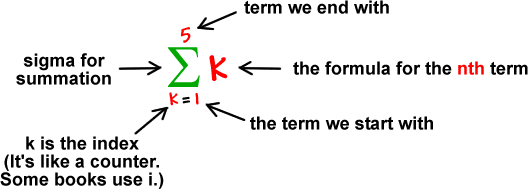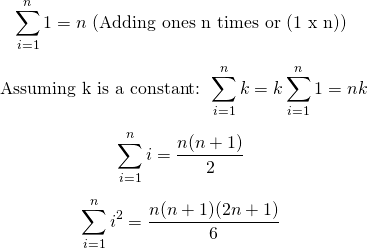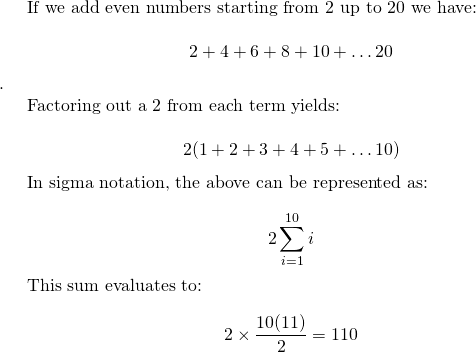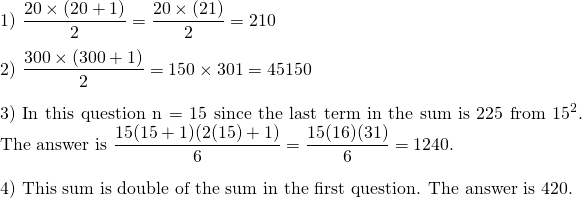Adding Numbers & Sigma (Sum) Notation
Hello. This post will be adding numbers with the sigma/sum notation. This particular math topic focuses on patterning, counting and adding numbers together.
This is a simplified version of my post on Sigma Notation from my website. This post focuses on finite sums and some basic sum formulas. No infinite sums nor sums with alternate signs are presented here.

Finite Sums
The field of mathematics is full of numbers, symbols, ideas, theories and relations. A common theme in math is displaying ideas in a compact manner.
Instead of writing down 1 + 2 + 3 + 4 + 5 + ... + 10, we write the following instead:


i = 1 to get 1 as the first term. The next case is when i = 2 to get 2, then i = 3 to get 3 all the way to the upper limit of i = 10. Because there is an upper limit that is non-infinite in the sum, we have a finite sum. (A sum that never ends is an infinite sum which is not covered here.)

Another version of a finite sum is where the upper limit is an arbitrary positive integer. As an example we can have:

The variable n is a positive whole number. It could be 10, 15, 20, 1000, 74 or 500.
Extension
Sums do not necessarily have to start at i = 1. They could start at i = 3 and end at 8. Also, the variable i is an index variable and can be changed. (This is similar to for loops in programming.) Other index variable choices include the letters k and j.

Sum Formulas
This section will briefly look at sum formulas. A more extensive look at sum formulas can be found in a university level Calculus course which focuses on Sequences and Series.
Here are a few sum formulas. (These start at a starting index of 1.)

Examples
Example One
The sum 1 + 2 + 3 + 4 + ... + 100

Example Two

Example Three (Representing Fractions In A Sum)
There are cases where we add fractions. Consider this example.

From term to term, the denominator increases by one. The sum above can be represented as:

Practice Problems
Here are some practice problems. Please refer to the summation properties and formulas.
Find the sum of the numbers from 1 to 20 (including 1 and 20).
Find the sum of the numbers from 1 to 300 (including 1 and 300).
Evaluate the sum
1 + 4 + 9 + 16 + 25 + 36 + 49 + 64 + 81 + 100 + ... + 225using summation notation and/or formulas.Find the sum of the even numbers from 1 to 40. That is, what is the total of
2 + 4 + 6 + 8 + ... + 40?
Solutions
Here are the solutions to the above problems.

Notes
There are more topics related to sigma/sum notation, series and other types of sums which are not covered here. These include Taylor series, Maclaurin series, Riemann sums, index shifting on sums and alternating series.
Your article has been upvoted and selected for Math-Trail Magazine N.14. You will also receive 5% of the author-rewards generated by the Magazine.
Thank you for the mention and selecting the article.
Very good article, You should write one like this but speaking about the multiplicatory pi notation.
Yes, there's the product version. Thank you for the idea.
I am Groot! :D
Congratulations @dkmathstats! You have completed some achievement on Steemit and have been rewarded with new badge(s) :
Click on any badge to view your own Board of Honor on SteemitBoard.
For more information about SteemitBoard, click here
If you no longer want to receive notifications, reply to this comment with the word
STOPHi, one image has not rendered properly:
You may wish to edit it.
Thank you for pointing this out. It is fixed now.